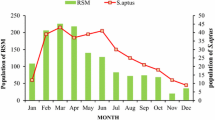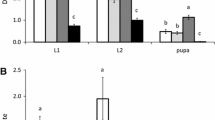Abstract
Amblydromalus zannoui Sourassou, Sarmento and Moraes is a phytoseiid mite of the limonicus group described from central Brazil from leaves of physic nut, Jatropha curcas L. (Malpighiales: Euphorbiaceae), a plant potentially useful as a source of biofuel. This plant is often attacked by the mites Polyphagotarsonemus latus (Banks) (Prostigmata: Tarsonemidae) and Tetranychus bastosi Tuttle, Baker and Sales (Prostigmata: Tetranychidae). The objectives of this work were to evaluate the predation rate of A. zannoui on those phytophagous mites, to assess its life cycle on these prey and on pollen of Ricinus communis L. (Euphorbiaceae), and to determine its attraction to physic nut leaves infested by P. latus or T. bastosi. Amblydromalus zannoui attacked more nymphs and adults than eggs of P. latus, and more eggs and larvae than adults of T. bastosi. The life table parameters suggest that A. zannoui performs better on P. latus (rm: 0.20, Ro: 18.77; λ: 1.23) and pollen (rm: 0.18, Ro: 23.32, λ: 1.18). The predator seems to be attracted to plants with P. latus, but attraction was not clear cut for plants with T. bastosi. The results suggested that A. zannoui is a potential control agent to be used against P. latus on physic nut plants, and that R. communis pollen can be used as supplementary food to maintain the predator population in the absence of prey.


Similar content being viewed by others
References
Abou-Awad BA, Hafez SM, Farhat BM (2014) Biological studies of the predacious mite Amblyseius swirskii, a predator of the broad mite Polyphagotarsonemus latus on pepper plants (Acari: Phytoseiidae: Tarsonemidae). Arch Phytopathol Pflanzenschutz 47:349–354
Bellini MR, Araujo RV, Silva ES, Moraes GJ, Berti Filho E (2010) Life cycle of Proprioseiopsis cannaensis (Muma) (Acari: Phytoseiidae) on different types of food. Neotrop Entomol 39:360–364
Cañarte E, Sarmento RA, Venzon M, Pedro-Neto M, Ferreira Junior DF, Santos FA, Pallini A (2017) Suitability and nutritional requirements of the predatory mite Typhlodromus transvaalensis, a potential biological control agent of physic nut pest mites. Biol Control 115:165–172
Chittenden AR, Saito Y (2001) Why are there feeding and nonfeeding larvae in phytoseiid mites (Acari, Phytoseiidae)? J Ethol 19:55–62
Coll M, Guershon M (2002) Omnivory in terrestrial arthropods: mixing plant and prey diets. Annu Rev Entomol 47:267–297
Cruz WP, Sarmento RA, Teodoro A, Pedro NM, Ignacio M (2013) Driving factors of the communities of phytophagous and predatory mites in a physic nut plantation and spontaneous plants associated. Exp Appl Acarol 60:509–519
Cruz WP, Sarmento RA, Pedro-Neto M, Teodoro AV, Rodrigues DM, Moraes GJ (2014) Population dynamics of Aceodromus convolvuli (Acari: Mesostigmata: Blattisociidae) on spontaneous plants associated with Jatropha curcas in central Brazil. Exp Appl Acarol 64:309–319
Cruz WP, Sarmento RA, Teodoro AV, Erasmo EAL, Pedro-Neto M, Ignacio M, Ferreira Junior DF (2012) Acarofauna em cultivo de pinhão-manso e plantas espontâneas associadas. Pesqui Agropecu Bras 47:319–327
Dicke M, Sabelis MW, De Jong M, Alers MP (1990) Do phytoseiid mites select the best prey species in terms of reproductive success? Exp Appl Acarol 8:161–173
Dicke M, Takabayashi J, Posthumus MA, Schütte C, Krips OE (1998) Plant-phytoseiid interactions mediated by herbivore-induced plant volatiles: variation in production of cues and in response of predatory mites. Exp Appl Acarol 22:311–333
Dinh NV, Janssen A, Sabelis MW (1988) Reproductive success of Amblyseius idaeus and Amblyseius anonymus on a diet of two-spotted spider mites. Exp Appl Acarol 4:41–51
Escudero LA, Ferragut F (2005) Life-history of predatory mites Neoseiulus californicus and Phytoseiulus persimilis (Acari: Phytoseiidae) on four spider mite species as prey, with special reference to Tetranychus evansi (Acari: Tetranychidae). Biol Control 32:378–384
Fan Y, Frederick LP (1994) Functional response of Neoseiulus barkeri Hugles on two-spotted mite (Acari: Tetranychidae). Exp Appl Acarol 18:613–621
Gilstrap FE, Friese DD (1985) The predatory potential of Phytoseiulus persimilis, Amblyseius californicus and Metaseiulus occidentalis (Acarina: Phytoseiidae). Int J Acarol 11:163–168
Gnanvossou D, Yaninek JS, Hanna R, Dicke M (2003) Effects of prey mite species on life history of the phytoseiid predators Typhlodromalus manihoti and Typhlodromalus aripo. Exp Appl Acarol 30:265–278
Janssen A, Bruin J, Jacobs G, Schraag R, Sabelis MW (1997) Predators use volatiles to avoid prey patches with conspecifics. J Anim Ecol 66:223–232
Maia AHN, Luiz AJB, Campanhola C (2000) Statistical inference on associated fertility life table parameters using jackknife technique: computational aspects. J Econ Entomol 93:511–518
McMurtry JA, Moraes GJ, Sourassou NF (2013) Revision of the lifestyles of phytoseiid mites (Acari: Phytoseiidae) and implications for biological control strategies. Syst Appl Acarol 18:297–320
McMurtry JA, Scriven GT (1964) Life-history studies of Amblyseius limonicus, with comparative observations on Amblyseius hibisci (Acarina: Phytoseiidae). Ann Entomol Soc Am 58:106–111
Messelink GJ, Bennison J, Alomar O, Ingegno BL, Tavella L, Shipp L, Palevsky E, Wäckers FL (2014) Approaches to conserving natural enemy populations in greenhouse crops: current methods and future prospects. BioControl 59:377–393
Messelink GJ, van Maanen R, van Steenpaal SEF, Janssen A (2008) Biological control of thrips and whiteflies by a shared predator: two pests are better than one. Biol Control 44:372–379
Meyer JS, Ingersoll CG, McDonald LL, Boyce MS (1986) Estimating uncertainty in population growth rates: Jackknife vs. bootstrap techniques. Ecology 67:1156–1166
Migeon A, Dorkeld F (2020) Spider mites web: a comprehensive database for the Tetranychidae. http://www1.montpellier.inra.fr/CBGP/spmweb. Accessed 15 Dec 2020
Moraes GJ, Mesa NC, Braun A, Melo EL (1994) Definition of Amblyseius limonicus group (Acari: Phytoseiidae), with description of two new species and new records. Int J Acarol 20:209–217
Oliveira H, Janssen A, Pallini A, Venzon M, Fadini M, Duarte V (2007) A phytoseiid predator from the tropics as potential biological control agent for the spider mite Tetranychus urticae Koch (Acari: Tetranychidae). Biol Control 42:105–109
Onzo A, Houedokoho AF, Hanna R (2012) Potential of the predatory mite, Amblyseius swirskii to suppress the broad mite, Polyphagotarsonemus latus on the gboma eggplant, Solanum macrocarpon. J Insect Sci 12:7
Pandey VC, Singh K, Singh JS, Kumar A, Singh B, Singh RP (2012) Jatropha curcas: a potential biofuel plant for sustainable environmental development. Renew Sustain Energy Rev 16:2870–2883
Pallini A, Janssen A, Sabelis MW (1997) Odour-mediated responses of phytophagous mites to conspecific and heterospecific competitors. Oecologia 110:179–185
R Development Core Team (2020) R: a language and environment for statistical computing. R Foundation for Statistical Computing, Vienna. https://www.r-project.org/ Accessed 15 May 2020
Rodríguez-Cruz FA, Venzon M, Pinto CMF (2013) Performance of Amblyseius herbicolus on broad mites and on castor bean and sunnhemp pollen. Exp Appl Acarol 60:497–507
Rodríguez-Cruz FA, Janssen A, Pallini A, Duarte MVA, Pinto CMF, Venzon M (2017) Two predatory mite species as potential control agents of broad mites. BioControl 62:505–513
Sabelis MW (1985) Predator-prey interaction: predation on spider mites. In: Helle W, Sabelis MW (eds) Spider mites: their biology, natural enemies and control, vol 1B. Elsevier, Amsterdam, pp 103–129
Samaras K, Pappas ML, Fytas E, Broufas GD (2015) Pollen suitability for the development and reproduction of Amblydromalus limonicus (Acari: Phytoseiidae). BioControl 60:773–782
Samaras K, Pappas ML, Fytas E, Broufas GD (2019) Pollen provisioning enhances the performance of Amblydromalus limonicus on an unsuitable prey. Front Ecol Evol 7:122
Saraiva AS, Sarmento RA, Erasmo EAL, Pedro-Neto M, Souza DJ, Teodoro AV, Silva DG (2015) Weed management practices affect the diversity and relative abundance of physic nut mites. Exp Appl Acarol 65:359–375
Sarmento RA, Rodrigues DM, Faraji F, Erasmo EAL, Lemos F, Teodoro AV, Kikuchi WT, Santos GR, Pallini A (2011) Suitability of the predatory mites Iphiseiodes zuluagai and Euseius concordis in controlling Polyphagotarsonemus latus and Tetranychus bastosi on Jatropha curcas plants in Brazil. Exp Appl Acarol 53:203–214
SAS Institute (2007) SAS system for windows 2000, version 8.2. SAS Institute, Cary, North Carolina, USA
Sourassou NF, Sarmento RA, Moraes GJ (2017) Description of a new species of the Amblydromalus limonicus (Acari: Phytoseiidae) species group based on morphological and molecular evidences. Int J Acarol 43:374–379
Vacante V (2015) Handbook of mites of economic plants: the identification, bio-ecology and control. CABI, Wallingford
van den Boom CE, van Bekk TA, Dicke M (2002) Attraction of Phytoseiulus persimilis (Acari: Phytoseiidae) towards volatiles from various Tetranychus urticae-infested plant species. Bull Entomol Res 92:539–546
van Lenteren JC (2012) The state of commercial augmentative biological control: plenty of natural enemies, but a frustrating lack of uptake. BioControl 57:1–20
van Lenteren JC, Bolckmans K, Köhl J, Ravensberg WJ, Urbaneja A (2018) Biological control using invertebrates and microorganisms: plenty of new opportunities. BioControl 63:39–59
Wäckers FL (2005) Suitability of (extra-) floral nectar, pollen, and honeydew as insect food sources. In: Wäckers FL, van Rijn PCJ, Bruin J (eds) Plant-provided food for carnivorous insects: a protective mutualism and its applications. Cambridge University Press, Cambridge, pp 17–74
Yaninek JS, Hanna R (2003) Cassava green mite in Africa—a unique example of successful classical biological control of a mite pest on a continental scale. In: Neuenschwander P, Borgemeister C, Langewald J (eds) Biological control in IPM systems in Africa. Cambridge University Press, Cambridge, pp 61–75
Acknowledgements
This study was financed in part by the Coordenação de Aperfeiçoamento de Pessoal de Nível Superior - Brazil (CAPES-PROCAD-AMAZÔNIA). We thank the National Council for Scientific and Technological Development (Conselho Nacional de Desenvolvimento Científico e Tecnológico – CNPq – Project: 306652/2018-8) for financially supporting this research.
Author information
Authors and Affiliations
Corresponding author
Ethics declarations
Conflict of interest
On behalf of all authors, the corresponding author states that there is no conflict of interest.
Additional information
Handling Editor: Marta Montserrat.
Rights and permissions
About this article
Cite this article
Miranda, V.C., de Azevedo, E.B., da Cruz, W.P. et al. Potential of the predatory mite Amblydromalus zannoui to control pest mites on Jatropha curcas. BioControl 66, 487–496 (2021). https://doi.org/10.1007/s10526-021-10080-z
Received:
Accepted:
Published:
Issue Date:
DOI: https://doi.org/10.1007/s10526-021-10080-z




